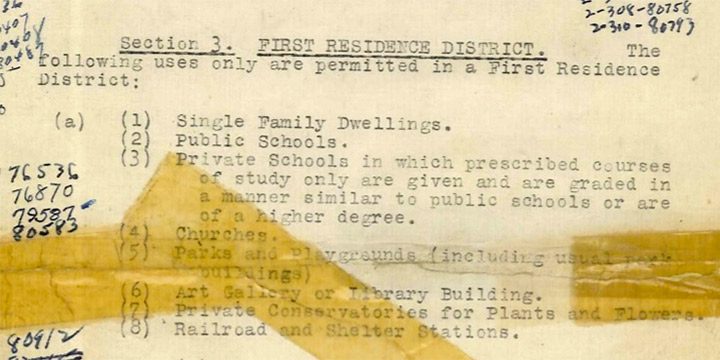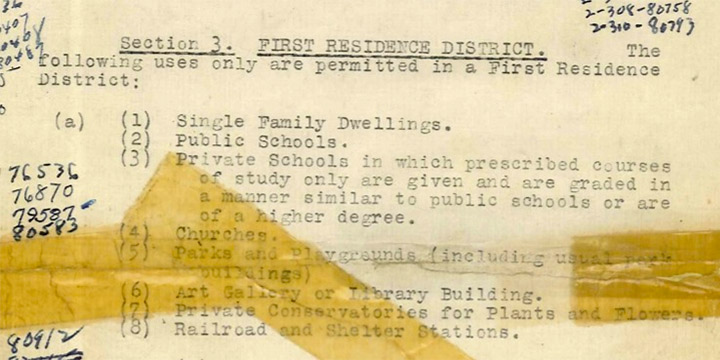A Daily Post reader questioned me yesterday about my statement that “Zoning has also been implicated as a primary factor in discouraging affordable housing in urban areas….” We can address her question this morning.
I approached the April 23 Town Planning Commission discussion — about re-zoning a single 5-acre parcel in the Harman Park subdivision — as an opportunity to talk about the concept of ‘zoning’ with a few of the people who actually pay attention to the concept, and who are responsible for the way zoning is used to control development in Pagosa Springs.
As suggested in Part Two yesterday, ‘zoning’ is a new concept, looking at the overall the history of human existence. Here in America, the first city to establish zoning regulations was Los Angeles in 1908, followed in quick succession by numerous other cities and small towns. By 1936, over 1300 American municipalities had adopted zoning rules. The constitutional validity of zoning was established by the US Supreme Court in 1926, in Village of Euclid, Ohio v. Ambler Realty Co.
For most of recent human history, villages and towns had been supported mainly by agricultural economies — by the cultivation of crops and livestock. Around the time of the American Revolution, for example, farmers made up about 90 percent of the labor force in the US.
By 1860, the proportion had dropped to about 60 percent, suggesting that maybe 40 percent of the country’s population was now involved in manufacturing (including resource extraction) and living mainly in urban cities and towns. By 1920 — when zoning regulations were rapidly appearing in American cities and suburbs — the proportion of farmers had fallen to about 25 percent.
Life in the big cities — with their dense populations and manufacturing economies — posed social challenges that had never existed in wide-open agricultural areas. One of those challenges was to somehow protect residential neighborhoods from the annoying odors and noise of factory operations.
The wealthier city dwellers also wanted to live at a distance from the working poor.

Prior to 1880, most people walked to work in American cities. As a result, the rich tended to live closest to their jobs, since long walks were bothersome as well as time consuming. That situation changed with the arrival of streetcars, and then even more radically with the mass-produced automobile.
From what I can tell, the first zoning ordinances in the early 1900s were intended for exactly that purpose: to require urban manufacturing, and multi-family apartments, to be located as far away as possible from single family residential neighborhoods.
Here’s a short quote from a fascinating 2001 essay by William Fischel of the Dartmouth College Department of Economics, titled “An Economic History of Zoning and a Cure for Its Exclusionary Effects”:
The development of electric-powered street railroads in the 1880s made it possible for urban workers to live in exclusively residential districts and commute daily to their jobs in the city. Streetcar lines grew from 3000 miles — all horse drawn — in 1882 to 22,500 miles of mostly electric lines in 1902. As the streetcar lines were constructed, homebuilders responded to the housing demands of people who could afford the not-inconsequential commuting fares, and the rich started to move to the suburbs…
Apartment developments tended to be located closest to streetcar lines, and also closest to factories… and income levels tended to increase as neighborhoods moved away from the urban core. This dynamic was encouraged by the real estate industry. A 1931 essay by the vice-president of the National Municipal League, William Munro, pointed out the financial advantages of legally-enforced separation:
With a city entirely zoned, they [realtors] could assure purchasers of residential property that their neighborhoods would never be encroached upon by business, while on the other hand, zoning would give business property a touch of monopoly value. Accordingly the signs went up on vacant lots: “Zoned for business,” or “Zoned for apartments,” with the definite implication that such action on the part of the public authorities had resulted in given the property a higher and more assured value than it would otherwise have…
In his essay, economist William Fischel notes that several groups had a vested interest in preserving the market value of homes in an urban or suburban neighborhood. First came the subdivision developer, who could buy up a large parcel for pennies on the dollar, chop it up into small lots, and sell the residential-sized parcels for top dollar — if they could show that the town had zoned the property to safely keep out commercial and multi-family.
Next came the realtor, who could promise the potential homeowner that their neighborhood was safe from encroachment by unwanted elements.
Then came the home buyers, who were making the largest investment of their lives, and wanted assurances that the home’s market value would likely increase — indefinitely — thanks to exclusionary zoning laws…
…And last, but certainly not least, came municipal governments themselves — dependent, as most are, upon property taxes. Cities and counties can assure themselves of maximum tax collections if they can preserve the market value of the residential and commercial properties in the community. Zoning regulations are the primary tool for preserving those values.
Market values were best preserved when apartments and mobile homes and manufacturing operations were kept at a reasonable distance from single-family homes. The fewer poor people in the community, and the longer the commuting distance to jobs and shopping and services, the better for everyone.
Or so it seemed.
Pagosa Springs and Archuleta County came rather late to the zoning game. When I moved to Pagosa in 1993, neither the Town nor the County had any zoning regulations. (The massive 21-square-mile Pagosa Lakes subdivision, however, had put its own covenants and restrictions in place back in the 1970s, to protect property values.) I don’t recall the year that the Town government adopted its zoning regulations, but the County government finally got around to putting zoning in place in 2006. The County’s adoption process was fairly simple, in that it merely enforced the types of neighborhoods that were already in place in 2006.
But zoning can be something of a double-edged sword, for governments. In 1999, Archuleta County purchased a 5-acre parcel on Hot Springs Boulevard, across the street from the Town’s proposed community center, with plans to one day build a new County Administration building there.
The parcel was subsequently zoned, by the Town, as “Public / Quasi Public.”
But during Archuleta County’s financial meltdown in 2006-2007, the County government wanted to sell that 5-acre parcel for $1.2 million — about twice what they’d paid for it — and needed to change the zoning to “commercial” or “residential” to make it marketable.
The Town Council refused to change the zoning.
That was then.


